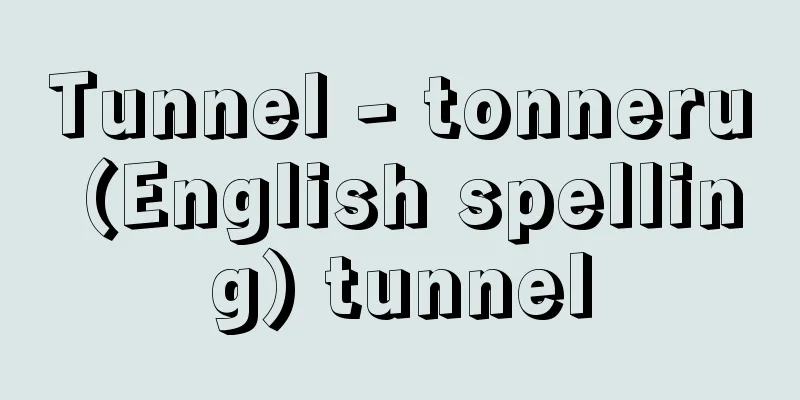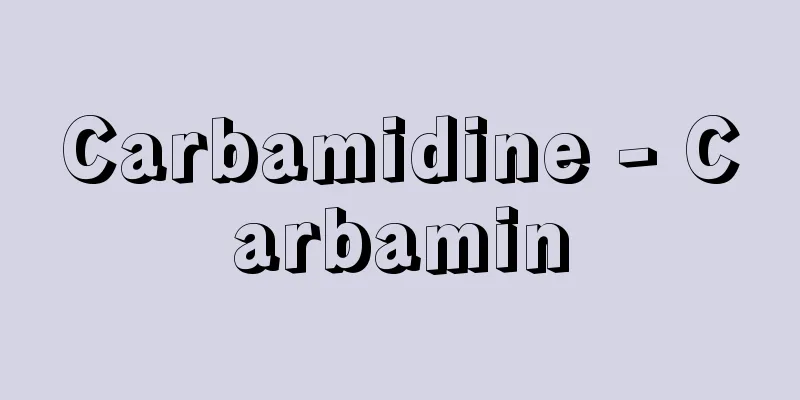Tunnel - tonneru (English spelling) tunnel

|
A passageway or underground cavity created below the ground surface. Also called a tunnel. However, this does not include those whose cross-sectional area is so small that they are considered pipes. The International Conference on Tunnels of the OECD (Organization for Economic Cooperation and Development) defines a tunnel as one with a cross-sectional area of 2 square meters or more. [Kouichi Sato] historyApart from tunnels (caves) used as residences, the history of tunnels began with irrigation tunnels. The oldest recorded transportation tunnel is a river tunnel in Babylon (present-day Iraq) 4,000 years ago. This tunnel was built to connect palaces and temples on both sides of the Euphrates River. In ancient Greece and Italy, construction of water facilities to supply water to cities was actively carried out, and large-scale aqueduct tunnels were built. As a result, during the reign of Emperor Tiberius, who executed Jesus Christ, 800,000 cubic meters of drinking water was supplied to Roman citizens per day. The Roman Empire built a road network spanning 80,000 kilometers to maintain its territory, and tunnels were used throughout it. In the Middle Ages, numerous tunnels were dug to mine copper, iron, rock salt, and other materials, and underground tunnels for tombs were also built within cities. In Japan, construction began on the Tatsumi Canal, which provided water for Kenrokuen Garden and Kanazawa Castle, in 1632 (Kan'ei 9), and a 2,000-meter-long waterway tunnel and a reverse siphon device called "Usegoshi" were built. In 1666 (Kanbun 6), construction began on the Hakone Canal (1,280 meters), the longest waterway tunnel before the Meiji era. A famous transportation tunnel is the Aonodomon (185 meters) in Yabakei, Oita Prefecture. According to the Buzen History, excavation began in 1735 (Kyoho 20), and it was opened 16 years later. After completion, a toll of 4 mon was charged per person and 8 mon for horses and cattle, setting a precedent for toll roads. Tunnels became more important with the Industrial Revolution as railways became the main form of land transportation. This was because railways were weak in steep mountainous areas, and it was necessary to dig tunnels to ease the gradient. Tunnel construction technology also improved significantly, with compressed air jackhammers being used in the Mont Cenis Tunnel (1857-1871, 13.65 km). Furthermore, dynamite was used instead of black powder in the Saint-Gothard Tunnel (1872-1882, 15.00 km). The advance piloting method was invented for the Simplon Tunnel I (1898-1906, 19.8 km), one of the longest tunnels in the world, which took about 70 years to build before the Daishimizu Tunnel was constructed. Japan's first railway tunnel was the Ishiyagawa Tunnel (61 meters) between Osaka and Kobe. This tunnel was designed by foreigners employed by the government, but in 1880 (Meiji 13), Japanese people constructed the Osakayama Tunnel (665 meters) independently, and in 1884, the Yanagase Tunnel (1.35 kilometers) was completed. As for waterway tunnels, the Nagarayama Tunnel (1885-90, 2.44 kilometers) of the Lake Biwa Canal was completed under the design and supervision of Tanabe Sakuro. In Japan, with its harsh terrain and many volcanoes, research into improving tunneling technology has been remarkable, and the Sasago Tunnel (1896-1903, 4.6 km), Shimizu Tunnel (1922-1932, 9.7 km), Tanna Tunnel (1918-1934, 7.8 km), and Kanmon Tunnel (1936-1944, 3.6 km) were excavated one after another. After World War II, long tunnels were constructed, such as the Oshimizu Tunnel (1971-1980, 22.22 km) of the Joetsu Shinkansen and the Kan'etsu Expressway Tunnel (1973-1985, 10.92 km). The pinnacle of these tunnels is the Seikan Tunnel (1964-1988, 53.85 km). An injection method was developed to stop the seawater from entering the tunnel, and the pilot tunnel was completed in 1983 (Showa 58), and it began operation in 1988. [Kouichi Sato] Uses and ClassificationsTunnels are used for transportation purposes such as railway and road tunnels, water tunnels for hydroelectric power generation and irrigation, and large-scale pipes for water supply and sewage and power lines. In addition, underground power plants and substations, and underground cavities for storing petroleum, are also considered to be included in the category of tunnels in a broad sense, as they are underground structures that use tunneling technology. In addition to being classified by use, tunnels are also divided into rock tunnels and earth tunnels depending on the geology that is the subject of excavation, and are further classified into mountain tunnels, urban tunnels, underwater tunnels, cut-and-cover tunnels, shield tunnels, immersed tunnels, etc. depending on the construction location and construction method. [Akira Kono, Hitoshi Shimizu, and Takashi Shigitani] Mountain tunnelUsually, the word "tunnel" refers to mountain tunnels that run through mountainsides, such as road or railway tunnels. A horseshoe shape is often used for the cross-section of a tunnel, as it is advantageous for withstanding earth pressure. The inside of an excavated tunnel is usually covered with a layer of concrete thick enough to withstand earth pressure, and finished to the specified internal cross-section. This is called lining. If the bedrock is hard, the lining may be omitted and the tunnel may be dug without any concrete. If the geology is poor, an invert (an arch-shaped lining with a concave upwards) may be added to create a closed cross-section and increase the load-bearing capacity, and if the earth pressure is strong, egg-shaped or circular cross-sections are often used. Mountain tunnel construction methods vary depending on the excavation style. When the geology is good, the entire cross section to be excavated can be excavated at once, but when the geology changes drastically or poor geology is present, a method is used in which a portion of the cross section is excavated first, and then the tunnel is gradually excavated to the specified cross section. Depending on the excavation sequence, there are the upper half section advance method, the bottom pilot advance upper half section method, and the side wall pilot advance upper half section method, and the method is selected according to the geology and construction conditions. Tunnel excavation is generally carried out by repeating a series of tasks: rock drilling, blasting, removal of rubble (crushed rock debris), erection of supports to prevent the collapse of the rock surface, and lining. Most of these tasks are mechanized, with drill jumbos, high-performance rubble loaders, rubble transporters, and underground locomotives used for excavation and removal of rubble, and mobile steel forms (steel forms) and various concrete pouring machines used for lining, in order to speed up construction and reduce labor. Although blasting is the main method of excavation, mechanical excavation is also used depending on the conditions. Tunnel excavation machines include boom-type free-section excavation machines and full-section excavation machines (also called tunnel boring machines). These tunnel excavation machines are limited in terms of their applicability to the geology and the cross-sections they can excavate, and the machines are expensive, but they have the advantages of high construction speed under good conditions and less noise and vibration than blasting methods. In the past, wooden supports were common, but after the Second World War, steel arch supports came into use. The adoption of steel arch supports made it possible to secure a large working space, completely changing the conventional tunnel construction method. In recent years, a new type of support and lining that uses rock bolts, sprayed concrete, and compressible supports to control the ground pressure and deformation has been introduced from Europe and is now being used. This method is called the New Austrian Tunnelling Method (abbreviated as NATM), and was first fully adopted in Japan in the late 1970s for the construction of the Joetsu Shinkansen. This method can be used in poor geological conditions, such as expansive ground that is subject to strong ground pressure that cannot be supported by conventional steel supports, and unconsolidated soft ground. It also allows for larger cross-section excavation than before, and has the potential to speed up construction and reduce labor by using large construction machinery, so its scope of application is tending to expand. Mountain tunnel construction in Japan is difficult in many ways due to the characteristics of its geology, and there have been remarkable advances in technology to deal with fractured zones, faults, and spring water. The Omachi Tunnel leading to the Kuroshio Dam, which was started in 1955 as the first tunnel to cross the Japanese Alps, encountered a high-pressure water eruption equivalent to a head of 420 meters. As a countermeasure, a bypass tunnel and a ground water drainage method using advanced drilling were adopted, and the tunnel successfully broke through the fractured zone. This method has become established as the standard method for breaking through fault spring water in mountain tunnels. Furthermore, in the construction of the Seikan Tunnel, research on the geology and prediction of spring water locations using long horizontal borings has progressed, and it has become possible to detect spring water locations in front of the tunnel face with a high degree of accuracy. In addition, great strides have been made in technology to stop water by injecting cement milk or other materials at high pressure from the advanced boreholes instead of draining the spring water. In the Joetsu Shinkansen Nakayama Tunnel, which was completed in 1981, the problem of a massive amount of well water, amounting to 130 tons per minute, was overcome by large-scale injection of chemicals, amounting to 100,000 cubic meters. These technologies have contributed greatly to the construction of long tunnels in various regions. [Akira Kono, Hitoshi Shimizu, and Takashi Shigitani] Cut and cover tunnelThis refers to a tunnel constructed by digging down from the ground surface, constructing a structure at a designated location underground, and then backfilling the top of it (called the cut and cover method). It is mainly used for subways, tunnels, underground roads, etc. in cities where the excavation depth is relatively shallow. In most cases, a rectangular box-shaped tunnel is used for the cross section of a cut and cover method, and reinforced concrete is usually used as the structural material. There are several cut and cover methods, such as the cut and cover method, which cuts the tunnel with a slope that prevents the collapse of the surrounding soil and keeps the ground stable, and the cut and cover method, which cuts the tunnel while installing retaining walls and shoring. In addition, when it is necessary to secure road traffic on the ground surface during construction, a method is used in which cross beams supported by piles and retaining walls are erected and a cover plate is laid on top of them to cover the tunnel. This is called road surface lining. [Akira Kono, Hitoshi Shimizu, and Takashi Shigitani] Shield TunnelShield tunneling is a method of constructing a tunnel by driving a tunneling machine with a strong cylindrical steel shell called a shield into the ground. Construction methods vary depending on the structure of the shield, but the shield is pushed into the ground by the thrust of a jack, supporting the face and the surrounding ground, while excavating with the cutting edge at the front end of the shield. At the rear of the shield, steel or reinforced concrete segments are assembled as the shield is advanced, and a lining is created, and backfill is injected to fill the gap between the lining and the ground. In addition, as a secondary lining, an inner lining of concrete is often applied inside the primary lining made of segments. There is also a method of lining the tunnel with cast-in-place concrete without using segments. There are various types of shield machines, including hand-excavated, semi-mechanical, mechanical, mud-pressurized, and earth-pressure-balanced, and auxiliary methods include compressed air method, which injects compressed air, chemical injection method, and groundwater level lowering method. The cross-sectional shape is generally circular, but there are also special shapes such as semicircular, horseshoe, rectangular, and eyeglasses. Tunnels with outer diameters ranging from about 2 meters to large cross-sectional shapes of over 10 meters are being constructed. The shield method was invented in the UK in the early 19th century, and was initially used as a construction method under special conditions, such as under-river tunnels or tunnels in soft ground with spring water. However, in recent years, the use of the shield method has increased rapidly for tunnel construction within cities due to issues such as ensuring road traffic during construction, noise and vibration issues, and the increasing need for grade separation and adjacent construction with various existing structures, and the shield method is now being widely adopted even in fields where conventional open-cut construction methods are used. [Akira Kono, Hitoshi Shimizu, and Takashi Shigitani] Immersed tunnelThe immersed tunnel method is a method for constructing tunnels at the bottom of rivers, canals, harbors, etc. The structure of the tunnel to be constructed is divided into pieces of appropriate length and fabricated on land in a dry dock or slipway. These tunnel elements are then floated on the water and towed to the site, where they are sunk into a dredged trench, and connected in sequence to construct the tunnel. The immersed tunnel method was first used in Boston Harbor at the end of the 19th century, and has since developed gradually, mainly in the United States and Europe, with many immersed tunnels now being built around the world. In Japan, the small but old Ajigawa River Underwater Tunnel (1944) was one of the earliest, and since then, immersed tunnels for a variety of purposes, including roads, railways, monorails, waterways, gas pipe tunnels, and belt conveyor tunnels, have been completed all over the country. Immersed tunnels are roughly divided into rectangular reinforced concrete structures developed mainly in Europe, and circular or oval cross-sections with steel shells that are widely used in the United States. Both are prefabricated. Some also use prestressed concrete structures. The largest cross-sectional sizes include the E3 Schelde Tunnel (Belgium), E3 Elbe Tunnel (Germany), and Tokyo Port Undersea Tunnel (Japan). The Tokyo Port Undersea Tunnel has three lanes each in both directions, with a total tunnel width of approximately 37 meters. The water depth at which it can be constructed is generally up to about 40 meters, but with improvements in construction technology and immersion machinery, the water depth at which it can be constructed is gradually expanding. [Akira Kono, Hitoshi Shimizu, and Takashi Shigitani] Pneumatic caisson construction methodIn the construction of tunnels using the pneumatic caisson method, the caisson bodies are generally arranged on the ground, and then submerged in order to a specified depth, and the bodies are connected to each other to form the tunnel. The pneumatic caisson method is often used in tunnel construction that requires crossing riverbeds, soft ground, or construction close to existing structures, because it allows dry excavation and allows reliable confirmation of ground strength. The pneumatic caisson method is also often used for part of tunnel construction, such as the connections at both ends of submerged tunnels, the outlets of waterway tunnels, and the shafts of shield tunnels. [Akira Kono, Hitoshi Shimizu, and Takashi Shigitani] Underground cavern excavationThere are relatively many examples of excavating underground cavities for underground power plants both in Japan and overseas, but in recent years, with the emergence of large-capacity pumped-storage power plants, the size of the cavities has expanded dramatically. The design and construction methods for excavating underground cavities are essentially the same as those for general mountain tunnel construction, but as the size of the cavities increases, the impact of excavation on the ground becomes more pronounced, so advance investigations, predictions, and construction with greater reliability and certainty are required than in normal cases. The geology of the construction site must be stable, hard, dense rock, but with the advancement of construction techniques such as rock bolts, rock PS (prestressing) works, and concrete spraying, as well as new knowledge of rock mechanics, it has become possible to excavate large stable caverns even in relatively poor geological conditions. Furthermore, various construction purposes are being implemented or planned, such as underground storage of petroleum and liquefied natural gas, and underground construction of nuclear power plants. [Akira Kono, Hitoshi Shimizu, and Takashi Shigitani] [References] | | | | | | | | | | | |Tatsumi |Tanabe Sakuro| | |Entrance to Sasago Station. Current Chuo Main Line outbound line. Sasago Village, Kitatsuru District, Yamanashi Prefecture (currently Sasago Town, Otsuki City). "Photographic Collection of Scenic Places and Historic Sites of Japan, Based on National Elementary School Textbooks, Heaven" (1912 (Meiji 45)) National Diet Library Collection "> Sasago Tunnel (Meiji Period) ©Shogakukan "> Tunnel shape based on geology ©Shogakukan "> Mountain tunnel excavation type The figure shows the standard construction sequence for subway construction using cut and cover earth retaining. This method involves digging down from the ground surface, constructing a tunnel structure at a designated location underground, and then backfilling the upper part. This method is used in relatively shallow underground locations and can be said to be the standard construction method for urban tunnels. First, piles are driven into the ground on both sides. Cross beams supported by piles and earth retaining walls are erected, and a covering plate is laid to cover the structure and ensure traffic on the road surface. Underground buried objects such as gas and water and sewerage are suspended from the buried object support beams to protect them. Next, the tunnel is excavated. The ribs are raised against spring water and earth pressure, and the piles are supported by struts. The soil is rolled up with buckets, etc. Dig to the designated depth, harden the gravel, build a foundation with concrete, and pour concrete for the upper and lower floors and side walls while carrying out waterproofing work. The buried objects are restored and backfilled with soil and sand. The support materials, covering plates, etc. are removed, and the road surface is restored . Cut and cover tunnel construction method (cut and cover method) A tunnel is created by pushing a cylindrical steel device called a shield into the ground with a jack attached to the rear of the device, and digging through the soil as it is advanced. As the shield advances, a steel or concrete frame (segment) is assembled inside the rear of the shield to create a lining, and the gap behind the lining, left behind when the shield is removed, is filled with mortar. This process is repeated to create the tunnel. Traditionally, the air pressure inside the tunnel was increased to prevent water from seeping in and the ground from collapsing (compressed air method), but recently auxiliary methods such as chemical injection and groundwater level lowering have also been used. The cross-sectional shape is generally circular . Shield tunnel construction method (shield method) This is a method for constructing a tunnel at the bottom of the water. First, a trench is dredged in the bottom of the water where the tunnel will be sunk, and stones and other materials are laid to make it flat. The structure of the tunnel to be constructed is divided into pieces of appropriate length (elements) and fabricated in a factory. Both sides are sealed with temporary walls to prevent sinking, and the elements are towed to the site and sunk into the already dredged tunnel installation point. Each element of the tunnel is joined in sequence, and the tunnel is completed by pouring soil over it. The tunnel element factory is usually built on the coast, but it can also be built in a floating dry dock moored near the site where it will be buried. The structure of immersed tunnels can be broadly divided into reinforced concrete structures, which are mainly used in Europe, and those with a steel shell developed in the United States . Immersed tunnel construction method (immersed tunnel construction method) The construction of the Seikan Tunnel, which reaches 240m below sea level, was carried out using new technologies. First, in addition to the main tunnel through which trains pass, three tunnels were excavated: an advance tunnel for geological and spring water surveys, and a work tunnel for transporting equipment and soil. Next, water-stopping agents were injected into the rock to stop the spring water and strengthen the ground so that it could withstand water pressure. The tunnel was excavated by repeating the injection and excavation process. Third, long-distance horizontal boring was carried out to know in advance the geological and spring water conditions in the direction of the tunnel, and a new method was established in the technology of excavating long distances horizontally rather than downward . Seikan Tunnel Construction Overview Source: Shogakukan Encyclopedia Nipponica About Encyclopedia Nipponica Information | Legend |
|
地表面下につくられた通路または地下空洞。隧道(ずいどう)ともいう。ただし、空洞の断面積があまりに小さく、いわゆる管に属するものは除かれる。OECD(経済協力開発機構)の国際トンネル会議では、断面積が2平方メートル以上のものをトンネルと定義している。 [佐藤馨一] 歴史住居としてのトンネル(洞窟(どうくつ))を別とすれば、トンネルの歴史は灌漑(かんがい)水路トンネルから始まっている。交通路としては、いまから4000年前、バビロン(現在のイラク)の川底トンネルが記録に残された最古のトンネルとされている。このトンネルは、ユーフラテス川の両岸にある宮殿と神殿をつなぐためのものであった。古代ギリシアやイタリアでは、都市へ水を供給するために水道施設の建設が盛んに行われ、大規模な水路トンネルが建設された。このことにより、イエス・キリストを処刑したティベリウス帝時代には1日80万立方メートルもの飲料水がローマ市民のために供給された。ローマ帝国はその版図を維持するために8万キロメートルに及ぶ道路網をつくったが、そこでも随所にトンネルが活用された。中世には銅、鉄、岩塩などを採掘するために多数の鉱道トンネルが掘られ、さらに墳墓用の地下トンネルが都市内に建設された。 日本では1632年(寛永9)に兼六園と金沢城に通水する辰巳(たつみ)用水が着工され、2000メートルに及ぶ水路トンネルや「伏せ越し」とよばれる逆サイホン装置がつくられた。また1666年(寛文6)には明治以前の最長水路トンネルである箱根用水(1280メートル)の工事が開始された。交通路トンネルとしては大分県耶馬渓(やばけい)にある青ノ洞門(185メートル)が有名である。豊前(ぶぜん)史によると、1735年(享保20)に掘削開始、16年後に開通したと述べられている。完成後は1人4文、牛馬は8文の通行料をとったとされ、有料道路の先例にもなっている。 トンネルは、産業革命を迎え、鉄道が陸上交通機関の主力となるにつれて重要性が増した。なぜならば、鉄道は急勾配(こうばい)の山岳地に弱く、トンネルを掘ることによって勾配の緩和を図る必要があったからである。またトンネル建設技術の改良も著しく、モン・スニ・トンネル(1857~71、13.65キロメートル)では圧縮空気削岩機が用いられた。さらにサン・ゴタルド・トンネル(1872~82、15.00キロメートル)では黒色火薬にかわってダイナマイトが使用された。大清水(だいしみず)トンネルが出現するまで約70年間、世界の長大トンネルの一つであったシンプロン・トンネルⅠ(1898~1906、19.8キロメートル)では先進導坑工法が考案された。 日本の鉄道トンネルの第1号は、大阪―神戸間にある石屋川トンネル(61メートル)である。このトンネルはお雇い外国人の設計によるものであるが、1880年(明治13)には日本人の独力により逢坂山(おうさかやま)トンネル(665メートル)を建設し、1884年には柳ヶ瀬(やながせ)トンネル(1.35キロメートル)を完成させた。なお水路トンネルとしては琵琶(びわ)湖疏水(そすい)の長等山(ながらやま)トンネル(1885~90、2.44キロメートル)が田辺朔郎(たなべさくろう)の設計監督により竣工(しゅんこう)した。地形が厳しく、しかも火山の多いわが国ではトンネル技術の改良研究が目覚ましく、笹子(ささご)トンネル(1896~1903、4.6キロメートル)、清水トンネル(1922~32、9.7キロメートル)、丹那(たんな)トンネル(1918~34、7.8キロメートル)、関門(かんもん)トンネル(1936~44、3.6キロメートル)などが続々と掘削された。また第二次世界大戦後には上越(じょうえつ)新幹線の大清水トンネル(1971~80、22.22キロメートル)や関越(かんえつ)自動車道トンネル(1973~85、10.92キロメートル)などの長大トンネルが建設された。その頂点にたつのが青函(せいかん)トンネル(1964~88、53.85キロメートル)である。ここでは海水を止めるために注入工法が開発され、1983年(昭和58)に先進導坑が貫通し、1988年に供用が開始された。 [佐藤馨一] 用途と分類トンネルの用途は、鉄道・道路トンネルなどの交通用、水力発電・灌漑などのための水路トンネル、上下水道・電線路などの管路が大型化したトンネルなどがある。このほか、地下発・変電所、石油類貯蔵用地下空洞なども、トンネル技術を適用した地下建造物として、広義にはトンネルに含めて考えられている。トンネルは用途による分類のほかに、掘削の対象となる地質によって岩石トンネルと土砂トンネルとに分けられ、また施工場所および施工の方法によって山岳トンネル、都市トンネル、水底トンネル、開削トンネル、シールドトンネル、沈埋(ちんまい)トンネルなどに細分類される。 [河野 彰・清水 仁・鴫谷 孝] 山岳トンネル普通、トンネルといわれるのは、山腹を貫く道路や鉄道などの山岳トンネルをさすことが多い。トンネルの断面形は、作用する地圧などに対して有利な馬蹄(ばてい)形が多用される。通常掘削されたトンネルの内面は、地圧に耐えうる厚さのコンクリートなどで被覆し、所定の内空断面に仕上げる。これを覆工(ふっこう)(ライニングlining)という。岩盤が堅硬な場合は覆工を省略し素掘りとすることもある。地質が悪い場合は、さらにインバートinvert(上に凹なアーチ形の覆工)を付して閉合断面を構成し耐荷力を増したり、地圧が強大な場合は卵形や円形断面もしばしば用いられる。 山岳トンネルの施工法は、掘削形式によってさまざまである。地質が良好な場合は掘削すべき全断面を一度に掘進することができるが、地質の変化が激しい場合や不良地質が存在する場合には、最初掘削断面の一部分を先行掘削したあとに順次所定の断面まで切り広げる方法がとられている。掘削順序によって、上部半断面先進工法、底設導坑先進上部半断面工法、側壁導坑先進上部半断面工法などがあり、地質や施工条件に応じ選択される。 トンネルの掘進は、一般に削岩、爆破、ずり(破砕された岩屑(いわくず))搬出、岩肌の崩壊を防ぐための支保工建込みおよび覆工という一連の作業の繰り返しによって行われる。これらの作業はほとんど機械化されており、掘削、ずり出しはドリルジャンボ、高性能ずり積込み機、ずり運搬車、坑内機関車、覆工では鋼製移動型枠(スチールフォーム)、コンクリート打設用各種機械が活用され、工事の急速化、省力化が図られている。また、掘削工法は発破工法が主力とされているが、機械掘削も条件に応じ採用される。トンネル掘進機としては、ブーム式の自由断面掘進機や全断面掘進機(トンネルボーリングマシンともいう)がある。これらのトンネル掘進機は、地質に対する適用性、掘削できる断面などの点で制約があり、機械も高価であるが、条件さえよければ施工速度が高いこと、発破工法に比べて騒音や振動が少ないことなどの利点がある。 支保工に関しては古くは木製が一般的であったが、第二次世界大戦後、鋼アーチ支保工が用いられるようになった。この鋼アーチ支保工の採用により大きな作業空間の確保が可能となり、在来のトンネル工法を一変させた。また、近年ではロックボルト、吹付けコンクリート、可縮支保工などを併用し地圧と変形量を制御する新しい支保工、覆工形式がヨーロッパから導入され、用いられている。この工法は新オーストリア工法New Austrian Tunnelling Method(略してNATM(ナトム)という)とよばれているもので、日本では1970年代後半に上越新幹線建設工事で初めて本格的に採用された。この工法は、在来の鋼製支保工では支えられないような強大な地圧が作用する膨張性地山や、未固結の軟弱な地山などの不良地質の場合にも適用できる。また、従来よりも大断面の掘削ができ、大型施工機械の投入による急速施工化、省力化を図りうる可能性を有しており、その適用範囲が拡大される傾向にある。 日本における山岳トンネル工事は、その地質の特質から諸外国ではあまり例をみない施工の困難さをもっており、破砕帯、断層、湧水(ゆうすい)などの処理技術の進歩は著しい。日本アルプスを横断する最初のトンネルとして1955年(昭和30)に着工された黒四ダムに通じる大町(おおまち)トンネルでは、水頭420メートルに相当する高圧水の噴出に遭遇し、その対策として迂回(うかい)坑、先進ボーリングによる地山水排除工法を採用して破砕帯の突破に成功した。この工法は山岳トンネルでの断層湧水箇所突破の標準工法として定着している。さらに青函(せいかん)トンネル工事では、長尺水平ボーリングによる地質と湧水箇所の予知に関する研究が進み、切羽(きりは)前方の湧水箇所をかなりの確度で検出できるようになった。また、湧水を排除するかわりに、この先進ボーリング孔からセメントミルクなどを高圧注入して止水する技術も長足の進歩を遂げた。1981年(昭和56)に貫通した上越新幹線中山トンネルでは、毎分130トンに及ぶ大量の湧水が注入量10万立方メートルに達する大規模な薬液注入によって克服された。これらの技術は各地の長大トンネルの施工に大きく寄与している。 [河野 彰・清水 仁・鴫谷 孝] 開削トンネル地表面から掘り下がり、地下所定位置に構築物を築造したのち、その上部の埋戻しを行う方法(開削工法という)により建設されたトンネルをいう。おもに都市における地下鉄、洞道、地下道路などのうち、掘削深さが比較的浅い場合に用いられている。開削工法によるトンネル断面には、ほとんどの場合、長方形の箱形トンネルが用いられ、構造材料には鉄筋コンクリートを採用するのが普通である。開削の方法としては、周辺の土砂の崩壊を防ぎ地盤の安定を保つような斜面の勾配(こうばい)をとって開削する法(のり)切り開削、土止め壁、支保工を施しながら開削する土止め開削工法などがある。また、工事中地表面の道路交通を確保する必要のあるような場合は、杭(くい)や土止め壁によって支持される横桁(けた)を架け渡し、この上に覆工板を張って覆蓋(ふくがい)する方法がとられる。これを路面覆工という。 [河野 彰・清水 仁・鴫谷 孝] シールドトンネル地盤内にシールドと称する強固な鋼製円筒状の外殻をもつ掘進機を推進させてトンネルを構築する工法をシールド工法という。施工法はシールドの構造によって異なるが、ジャッキ推力によりシールドを地中に押し込み切羽および周辺地山を支持しながら、シールド前端の刃口で掘削を行う。シールド後部では推進につれて鋼製または鉄筋コンクリート製のセグメントを組み立てて覆工を行い、裏込め注入を行って覆工と地山との間の空隙(くうげき)を充填(じゅうてん)する。さらに二次覆工として、セグメントによる一次覆工の内側に内巻きコンクリートを施工する場合も多い。また、セグメントを用いず現場打ちコンクリートにより覆工しながら掘進する工法もある。シールド機の種類には手掘り式、半機械掘り式、機械掘り式、泥水加圧式、土圧バランス式などがあり、補助工法としては、高圧空気を送入する圧気工法、薬液注入工法、地下水位低下工法などが用いられる。断面形状は円形が一般的で、特殊なものとしては半円形、馬蹄形、長方形、めがね形などがある。トンネル外径が2メートル程度のものから10メートル以上の大断面のものまで施工されている。 シールド工法は19世紀初めにイギリスで考案され、当初河底トンネルや湧水のある軟弱な地盤のトンネルなど特殊な条件下における工法として利用されてきた。しかし、近年、都市内のトンネル工事は、施工時の路面交通の確保、騒音・振動の問題、各種既設構造物との立体交差や近接施工の必要性の増大などからシールド工法の採用例が急増し、在来の開削工法の分野までシールド工法が広く採用される傾向にある。 [河野 彰・清水 仁・鴫谷 孝] 沈埋トンネル沈埋工法は河川、運河、港湾などを横断して水底にトンネルを建設するための工法で、建設するトンネルの構造体を適当な長さに分割して陸上のドライドックや造船台で製作し、このトンネルエレメントを水上に浮かべて現場まで曳航(えいこう)し、あらかじめ浚渫(しゅんせつ)した溝(トレンチ)の中に沈設し、これを順次接続してトンネルを建設する工法である。 沈埋工法は19世紀末にボストン港で初めて施工され、以降アメリカおよびヨーロッパを中心にしだいに発展し、現在では世界各国で数多くの沈埋トンネルが建設されている。日本では、小規模ながら古くは安治川(あじかわ)河底トンネル(1944)があり、その後、道路、鉄道、モノレール、水路、ガス配管トンネル、ベルトコンベヤートンネルなど種々の用途の沈埋トンネルが各地で完成している。 沈埋トンネルの構造は、ヨーロッパを中心に発達した長方形断面の鉄筋コンクリート構造と、アメリカで多用されている円形あるいは小判形断面で鋼殻を有するものとに大別され、いずれもプレハブ形式である。また、一部にはプレストレストコンクリート構造も採用されている。断面寸法で最大級のものとしては、E3シェルデトンネル(ベルギー)、E3エルベトンネル(ドイツ)、東京港海底トンネル(日本)などがあり、東京港海底トンネルの場合、上下各3車線を有し、トンネル総幅員は約37メートルに達する。施工水深は一般には40メートル程度までであるが、施工技術や沈設機械などの向上とともに施工可能水深も順次拡大される傾向にある。 [河野 彰・清水 仁・鴫谷 孝] ニューマチックケーソン工法ニューマチックケーソン工法によるトンネルの施工は、一般にケーソン躯体(くたい)を地上部に配列し、これを順次、所定の深さまで沈設し、相互の躯体を連結してトンネルを構成する。ニューマチックケーソン工法はドライで掘削が行えること、地盤強度の確認が確実に行えることなどにより、河底横断や軟弱地盤、あるいは既設構造物への近接施工などを要求されるトンネル工事に施工例が多い。また、沈埋トンネル両端の接続部や水路トンネルの取放口、シールドトンネルの立坑など、トンネル工事の一部にニューマチックケーソン工法を用いる場合も多い。 [河野 彰・清水 仁・鴫谷 孝] 地下空洞掘削地下発電所などの地下空洞の掘削例は国内外とも比較的多いが、近年大容量揚水式発電所が出現するに及んで空洞規模は飛躍的な拡大をみている。地下空洞掘削の設計・施工法は、本質的には一般の山岳トンネル工事と異ならないが、空洞規模が大きくなると掘削による地山への影響が顕著に及ぶので、通常の場合以上に事前の調査、予測および施工の信頼性と確実性が必要とされる。 建設地点の地質は堅硬緻密(ちみつ)な安定した岩盤であることが要求されるが、ロックボルト、岩盤PS(プレストレス)工、コンクリート吹付けなどの施工技術の進歩と岩盤力学の新しい知識を加えて、ある程度不良の地質条件においても安定した大空洞を掘削できるようになってきた。さらに、施工目的としても、石油、液化天然ガスの地下貯蔵や、原子力発電所の地下化など、種々のものが実施あるいは計画されている。 [河野 彰・清水 仁・鴫谷 孝] [参照項目] | | | | | | | | | | | | | | | | |笹子駅方入口。現在の中央本線下り線。山梨県北都留郡笹子村(現在の大月市笹子町)。『日本名勝旧蹟産業写真集 国定小学校教科書準拠 天』(1912年〈明治45〉)国立国会図書館所蔵"> 笹子トンネル(明治時代) ©Shogakukan"> 地質によるトンネルの形状 ©Shogakukan"> 山岳トンネルの掘削形式 図は、路面覆工式土止め開削による地下鉄工事の標準的な施工順序を示す。地表から掘り下げ、地下の所定位置にトンネル構築物を建造したあと、その上部を埋め戻す方法である。地下の比較的浅い場所に用いられ、都市トンネルの標準的工法といえよう。まず両側に杭を打ち込む。杭や土止め壁によって支持される横桁を架け渡し、覆工板を張って覆蓋し、路面の交通を確保する。埋設物支持桁より、ガス、上下水道などの地下埋設物を吊り下げて防護する。次に、坑内を掘削していく。湧水、土圧などに対して腹起し、切梁で杭を支持する。土はバケットなどで巻き上げる。所定の深さまで掘り、敷砂利を固めてコンクリートで基礎をつくり、防水工を施しつつ上・下床、側壁などにコンクリートを打設する。埋設物を復旧し、土砂で埋め戻す。支保工材、覆工板などを撤去し、路面復旧する©Shogakukan"> 開削トンネルの工法(開削工法) シールドとよばれる鋼鉄製の円筒形装置を、その後部に取り付けたジャッキで地中に押し込んで推進させながら土を掘削し、トンネルをつくる方法。シールドの推進につれて、シールド後部内で鉄あるいはコンクリート製の枠(セグメント)を組み立てて覆工を行い、覆工の裏のシールドの抜けたあとのすきまにはモルタルを充填する。この作業を繰り返してトンネルをつくっていく。湧水や地山の崩落を防ぐため、トンネル内の気圧を高くして行う方法(圧気工法)が従来用いられてきたが、最近は薬液注入工法、地下水位低下工法などの補助工法も用いられる。断面形状は円形が一般的である©Shogakukan"> シールドトンネルの工法(シールド工法) 水底にトンネルを建設するための工法である。まず、トンネル沈設箇所の水底に溝を浚渫し、石などを敷いて平らにする。建設するトンネルの構造体は適当な長さに分割して(エレメント)工場で製作し、沈まないよう両側を仮壁で密閉して現場まで曳航して、すでに浚渫されたトンネル設置点に沈められる。トンネルの各エレメントを順次接合し、土砂がかけられてトンネルが完成する。トンネルエレメントの工場はたいてい海岸につくられるが、埋設する近くに係留した浮きドライドックでつくられることもある。沈埋トンネルの構造は、ヨーロッパ中心の鉄筋コンクリート構造とアメリカで発達した鋼殻を有するものとに大別される©Shogakukan"> 沈埋トンネルの工法(沈埋工法) 海面下240mに達する青函トンネルの工事は、新技術を駆使して行われた。第一に、列車を通す本坑のほかに、地質・湧水調査のための先進導坑、機材や土砂の運搬を行う作業坑の計3本のトンネルを掘削した。次に、湧水を止め、水圧に耐えるよう地盤を強化するために、岩盤止水薬注入を行った。注入・掘削の作業を繰り返してトンネルを掘り進めた。第三は長尺水平ボーリングで、トンネルを方向の地質・湧水状態を事前に知るために行われ、下方でなく、水平に長距離を掘削する技術において新しい方法を確立した©Shogakukan"> 青函トンネルの工事概要 出典 小学館 日本大百科全書(ニッポニカ)日本大百科全書(ニッポニカ)について 情報 | 凡例 |
<<: Tunnel kiln - Tunnel kiln (English name)
>>: Donner - What kind of (English spelling) Georg Raphael Donner
Recommend
Sanskrit sound - Bonon
〘Noun〙 (also called "bonnon" in the &quo...
Arahabakigami - Arahabakigami
...In the case of guest gods, unlike the above tw...
Righteous person
〘 noun 〙 A person who firmly adheres to righteousn...
Vesakha Festival - Vesakha Festival
In southern Buddhism, this festival is held to cel...
Lubbers, RFM (English spelling) LubbersRFM
...In the elections of September of that year, th...
Ayuntamiento - Ayuntamiento
…also called ayuntamiento, translated as city cou...
Harbor News Association
...Abbreviation for Associated Press, it has the ...
Sminthillus limbatus (English spelling) Sminthilluslimbatus
... The genus Atelopus , which is a toad but has ...
Advertisement - Advertisement
Ortāg was an association of Islamic usury merchant...
Foz do Iguaçu (English spelling)
A city on the Parana River in the western part of ...
Corfu [island] - Corfu
A Greek territory on the west coast of Greece, at ...
Catharacta skua maccormicki (English spelling) Catharacta skua maccormicki
...All three species are seen passing through the...
Turkish hat - tarboosh
A fez is a Muslim male hat in Egypt, Arabia, and T...
Yallow, R. (English spelling) YallowR
...A well-type scintillation detector is mainly u...
Karagas - Karagasu
…Turkic-speaking herders who live in the area of ...









